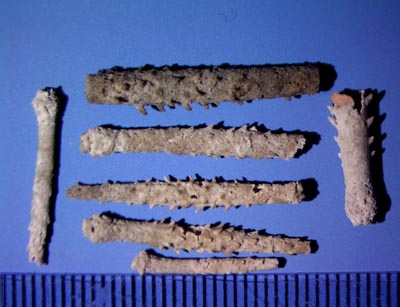|
The Fort
Apache Limestone contains at least two species of Urchins, a
smooth spined and one with barbs. After clams, this is the most
common element found in our acid fines, made by dissolving the
limestone directly in 5-10% muriatic. Many of the silicified
remains are highly crystallized and have lost much of their original
detail. Here, we are displaying the best of the lot - hand picked
under a microscope with tweezers out of the acid fines and separated
according to type.
Every invertebrate
is tiny in the Fort Apache Limestone. Permian in age, it represented
a brief incursion of the sea onto the Schnebly Hill formation
dunes forming a 50 foot thick sequence at our fossil locality
along the Highland Trail. I will repeat here what we have said
before - Fossils are so very rare in this formation, that any
fossils at all are a rare glimpse into this enigmatic brief period
of time.
 |
Spine
plates from the body (test) of small urchins. The millimeter
scale at the bottom shows the range in sizes we encountered.
The test would have been roughly 1 - 2 inches in size. |
 |
Close
up of one of the better preserved specimens. The round mound
in the center is what a spine rests on and pivots around to move
the animal along. |
 |
Two
different spine types here. On the left and along the bottom
is the smooth spined type, which is a very generic appearance
for a spine. The larger spines with smaller points along their
length were identified by Winters in 1963 as Echinocrinus trudifer. |
 |
Close
up of spiny spines using a 5 layer focus stack method. |
 |
Close
up of smooth spine. |
 |
This
seems to be a very small spine type, we found a few of these
in nearly 200 pounds of limestone fines. Most seem to be very
tiny, and this would have been a marble sized echinoid. |
 |
Smooth
spine types of unknown echinoid. |
 |
Small
plates around the periproct (top) of the urchin, appear to be
genital plates with the hole being the gonopore. We found all
of this set in the first round of limestones, and never after
that. |
|

